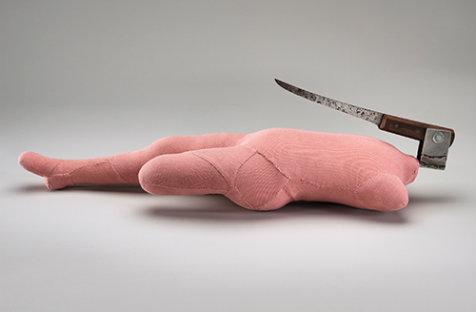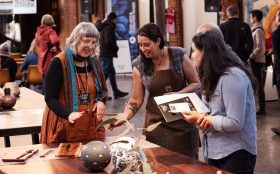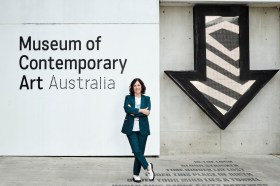In 1974, in conversation with Lucy Lippard, French-American artist Louise Bourgeois (1911 – 2010) stated that the function of her art was to follow ‘the inner necessity, to release anxiety into a formal perfection’. She is quoted in the current Heide exhibition, Louise Bourgeois: Late Works, as saying ‘Everyday, you have to abandon your past or accept it, and then, if you cannot accept it, you become a sculptor’.
Bourgeois, born in Paris in 1911, began her artistic career in the 1930s, and witnessed numerous art movements during her lifetime, including Surrealism, Abstract Expressionism, Pop Art, Fluxus and the women’s art movement. She moved from France to the USA in 1938, and her artistic journey saw her immersed in the social and artistic tidal waves of 1960’s New York, and rubbing shoulders with the likes of Méret Oppenheim (of ‘Fur Teacup’ fame), Marcel Duchamp, and soft sculpture pioneer Jann Haworth. Bourgeois’ defining approach was to use her practice therapeutically to deal with the traumas of the past that resonated in her adult life.
Bourgeois was over 85 when the body of work now showing at Heide was produced and 98 when she produced her final works. Her most recent work in the exhibition is a fabulous series of etchings, View from the Bottom of the Well (2009). Simple drawings, they nonetheless manage – with typical Bourgeois knack – to convey the artist’s complex feelings without losing a certain classical cool.
Louise Bourgeois: Late Works confirms her as a mighty figure in the canon of contemporary sculpture, and a key figure in the feminist movement, both formally and as a voice speaking out against emotional repression and social taboos. The personal nature of her work does not prevent it from being refreshingly accessible; Bourgeois has in some ways a very literal imagination and is happy to explain her work to the viewer.
The work Cinq (1997), which comprises five sewn fabric heads, hanging from a hook, was an image of her own nuclear family, Bourgeois said. The sculpture hangs on a butcher’s hook and the intimacy of family is likened to a physical intimacy bunch of bananas.
A five metre high metal spider that presides over the central room of the gallery, towering over a caged chair, is declared by Bourgeois to be a metaphor for her mother and herself, the feminine energy in her family experienced by her as a protective, caring presence.
There is a voodoo quality to her work; a witches brew in which the ingredients’ potency intensified as she grew older, to the point of using her own artefacts as the basis of the work. Blue Days (1996) is comprised of six of the artist’s dresses. The exhibition also contains prints, watercolours and texts by Bourgeois.
Her representation of the female body provides a welcome contrast to a contemporary world saturated with soft porn images of women. In Bourgeois’ world, sculpted bodies are not hard, erect objects but soft, penetratable ones. As a female viewer, the mass media’s impossible provocation to all women to be fatless and firm is conjured; I feel Louise Bourgeois is winking at me through these sculptures, conveying a grandmotherly wisdom, and a warning. One soft sculpture is a legless, headless, armless woman, with only her breasts upstanding and her sewn fabric vulva open to be penetrated by all who see her. She is a vulnerable figure, a reduction of the woman’s body, eternally laid on her back, unable to run, breasts ever pert.
Another sculptural piece, Couple IV (1997) presents a headless male figure lying upon a headless female figure, again a soft sculpture made of fabric. The use of sewing and fabric quietly states Bourgeois’ quiet confidence in reasserting traditional female crafts such as doll making and needlework as valuable in the fine art context, and it operates in effective juxtaposition to the work’s dark psychological content.
Bourgeois’ work brings to mind that the artist’s hands are the sewing hands of an old woman. Old ladies are usually the last demographic that come to mind when the image of an artist is conjured in most people’s minds, but why is that?
Louise Bourgeois hails from a time when there were many outspoken female artists whose art practice openly repositioned women as the subjects of art by women, including Carolee Schneemann, Méret Oppenheim, Nancy Spero, Judy Chicago and Niki de Saint Phalle – as well as Bourgeois herself. It is exciting to see these women’s work increasingly celebrated in the mainstream art world now, when they were frequently overlooked and isolated from it in the past. Louise Bourgeois: Late Works is a small treasure trove of Bourgeois’ work; a visit to Heide to view the exhibition is highly recommended before it flies back to New York.
Rating: 4.5 stars out of 5
Louise Bourgeois: Late Works
Curator: Jason Smith
Heide Museum of Modern Art, Bulleen
24 November 2012 – 11 March 2013





